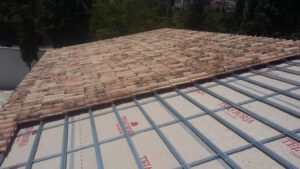During a roof installation, it is necessary to take a few safety precautions to avoid damage to the roof. The first thing to do is to prepare your roofing materials. You will need a ladder, roof screws, and rubber washers. All of these tools are necessary for a safe and successful roof installation. Listed below are the steps to complete your roof installation. Once you are sure you have all the materials you need, it is time to install your new roof.

Start by tearing off the old roof. This is necessary for installing new flashing and underlayment. You will have to remove old nails, so use a hammer and pound them flat. Be sure to lay tarps over your landscaping. You can also use tarps to catch thousands of nails as they fall from the roof. It is also essential to position the ladder so that it is not in the way of the roof’s edge.
After removing the old roof and placing the felt paper, the next step is to install the shingles. These shingles will weigh nearly 70 pounds, so it is essential to measure each one carefully. Measure from the drip edge to the edge of the roof and the other end of the roof to ensure proper spacing. Each shingle should have three tabs. Then, cut the excess felt paper at these points. After that, cut the shingles so that they meet correctly.
The felt paper should overlap the underlayment. Don’t cut the felt paper; it’s important to leave enough space for the underlayment to overlap it. As shown in photo seven, the underlayment overlaps the felt on one side, which keeps the water from soaking into the fascia. Also, the center of the felt paper should not extend over gutters. You should then apply the final coat of paint. If you’re unsure about the proper method for installing your roof, you can use an attic ventilation calculator. Simply type in the dimensions of your attic to get the right number of vents. Cut holes for attic ventilation.
When you’re ready to install your new roof, consider hiring a professional. They adhere to strict guidelines and offer an industry-leading warranty. This means that you’ll have a roof that lasts for many years. They’ll ensure the safety of your family and home. You can even get your roof repaired if something happens.
Before hiring a roofing contractor, look at their previous jobs and talk to past customers. Make sure the contractor has experience with your desired product. Make sure they are insured and have the proper licenses to work on the roof. Make sure you talk to previous customers so you can verify the reliability of the company’s services. Ensure that they have experienced crews that understand the process. They will also be able to give you valuable tips about roof installation and repair.
During the roof installation process, you will have to remove the old roof and the tar paper. This is essential as the area experiences heavy rains during the summer months and hurricane season. Your roofing contractor will also install a water barrier around the edges of the roof. This barrier is secured to the structure and provides added stability against strong winds. The new roof will be protected from any water damage that comes with heavy rainfall. It’s important to ensure that your new roof is constructed in the best possible way to handle the elements and prevent damage caused by water.
In addition to the proper ventilation, the right roof installation will ensure that your home is safe and secure. This process starts with preparing the roofing materials. If you plan on using PVC roofing materials, make sure that you follow the manufacturer’s recommendations. The best way to prepare your roof for this type of installation is to get a professional roofing company that is experienced and skilled in doing such jobs. The process will be easier if you’ve already gathered the necessary information.
Installing your roof using self-drilling screws is another way to get a secure, safe roof. To install these, you should purchase an adhesive starter strip. This strip has a continuous adhesive on the back that creates an effective seal. Make sure you know where the vents are before you begin the roof installation. These are the places where water can penetrate through the roofing and leak into the interior of your home. Then, your roofing contractor should pre-drill the holes on the backside of the panels to ensure that they are not exposed.